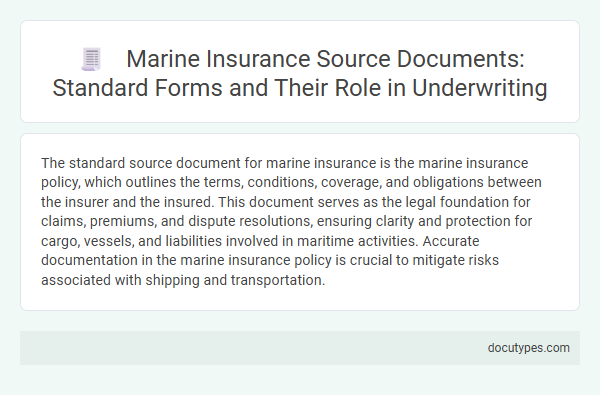The standard source document for marine insurance is the marine insurance policy, which outlines the terms, conditions, coverage, and obligations between the insurer and the insured. This document serves as the legal foundation for claims, premiums, and dispute resolutions, ensuring clarity and protection for cargo, vessels, and liabilities involved in maritime activities. Accurate documentation in the marine insurance policy is crucial to mitigate risks associated with shipping and transportation.
Introduction to Marine Insurance Source Documents
The standard source document for marine insurance is the marine insurance policy. This document outlines the terms, coverage, and conditions agreed upon by the insurer and the insured party.
Marine insurance source documents serve as the legal foundation for claims and coverage in maritime shipping and cargo protection. These documents typically include the insurance policy, the bill of lading, and the certificate of insurance, which collectively verify ownership, shipment details, and insurance validity. Accurate source documents ensure transparency and dispute resolution in ocean trade and transportation.
The Importance of Standard Forms in Marine Underwriting
| Topic | Details |
|---|---|
| Standard Source Document for Marine Insurance | The standard source document in marine insurance is the Marine Insurance Policy. This legal contract outlines the terms, conditions, coverage, and exclusions related to the insured marine risks. It serves as the primary reference during claims, underwriting, and dispute resolution. |
| The Importance of Standard Forms in Marine Underwriting | Standard forms in marine underwriting establish consistency and legal clarity, reducing ambiguity in coverage interpretation. They help underwriters assess risk accurately while maintaining industry-wide benchmarks. These forms protect your interests by providing well-defined terms agreed upon by insurers and insured parties. Using standardized documentation streamlines policy issuance and claims processing, minimizing disputes and fostering trust among stakeholders. |
Bill of Lading: Definition and Underwriting Significance
What is the standard source document for marine insurance underwriting? The Bill of Lading serves as the primary document in marine insurance, detailing the shipment's contents, destination, and consignee. This document provides critical information that underwriters use to assess risk and determine coverage terms.
Commercial Invoice: Key Data for Underwriters
The standard source document for marine insurance is the commercial invoice, which provides essential details about the goods being shipped. This document includes key data such as the description of the cargo, its value, and the terms of sale, all critical for underwriters to assess risk accurately. Underwriters rely on the commercial invoice to verify shipment details and calculate appropriate insurance premiums for marine coverage.
Cargo Insurance Policy Documents: Core Elements
The standard source document for marine insurance is the cargo insurance policy, which outlines the terms and conditions of coverage for goods in transit. This document serves as the primary contract between the insurer and the insured, specifying the details of the insurance arrangement.
- Insured Parties - Identifies the owner of the cargo and the party covered under the policy.
- Coverage Details - Specifies the type of risks insured against, including perils such as damage, theft, and loss during shipping.
- Policy Conditions - Includes clauses detailing policy limits, deductibles, and procedures for claims and dispute resolution.
Understanding these core elements is essential for ensuring proper marine cargo insurance protection and compliance.
Survey Reports and Inspection Certificates
The standard source document for marine insurance primarily consists of survey reports and inspection certificates. These documents provide critical evidence regarding the condition and value of the insured cargo or vessel at specific points in the shipping process.
Survey reports offer detailed assessments conducted by qualified marine surveyors, highlighting damages, losses, or compliance with shipping standards. Inspection certificates certify the seaworthiness, safety, and adherence to regulatory requirements of the ship or cargo, serving as essential references for insurance claims.
Packing List: Role in Risk Assessment
The packing list is a critical source document in marine insurance, serving as a detailed inventory of the goods being shipped. It provides essential information that helps insurers assess potential risks associated with the cargo.
- Itemized Content - The packing list details the quantity, description, and packaging of each item, allowing for precise valuation and risk identification.
- Verification Tool - Insurers use the packing list to verify the consistency between the shipped goods and the insured items, minimizing discrepancies and fraud.
- Damage Assessment - In the event of a claim, the packing list aids in determining possible exposure to damage during transit, influencing claim evaluation and settlement.
Certificate of Origin: Implications for Marine Insurance
The standard source document for marine insurance is critical in verifying the shipment's authenticity and origin. The Certificate of Origin plays a significant role in marine insurance by providing essential details about the goods being transported.
This document ensures accurate risk assessment and compliance with international trade regulations, directly impacting your insurance coverage.
- Proof of Origin - The Certificate of Origin certifies where the goods were manufactured, affecting eligibility for coverage under specific marine insurance policies.
- Customs Compliance - Insurers use this document to confirm that shipments meet destination country regulations, reducing the risk of denied claims.
- Claim Validation - In case of damage or loss, the Certificate assists in validating claims by proving the goods' origin and shipment details.
Freight Contract Agreements and Their Insurance Impact
The standard source document for marine insurance is the freight contract agreement, which outlines the terms and conditions of cargo transportation by sea. This contract directly influences the scope and coverage of marine insurance policies by specifying the liabilities and responsibilities of each party involved. Understanding your freight contract agreement is crucial to ensure that your marine insurance aligns with the actual risks and obligations during shipment.
What Is the Standard Source Document for Marine Insurance? Infographic

